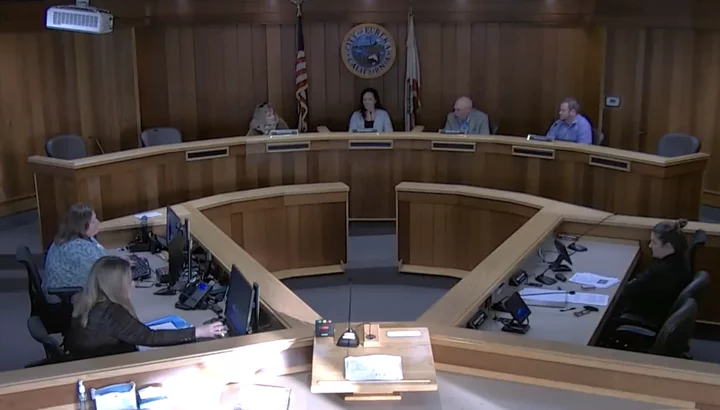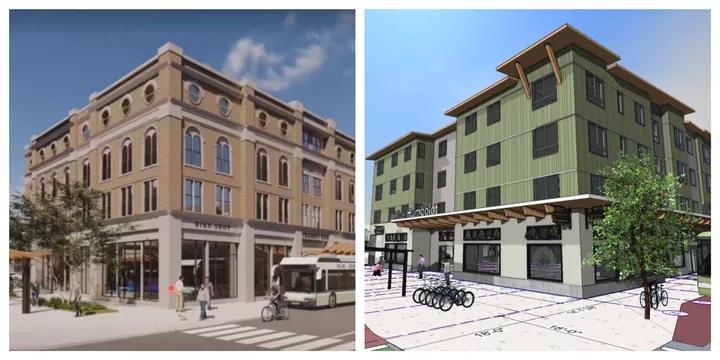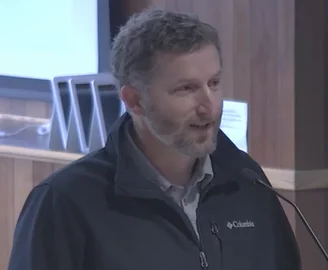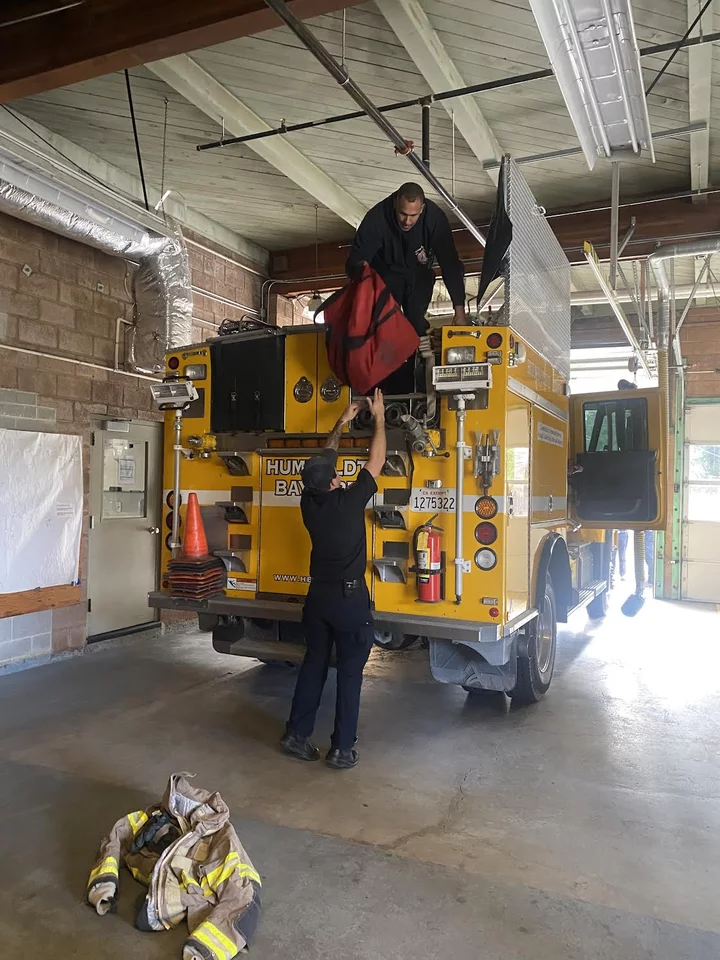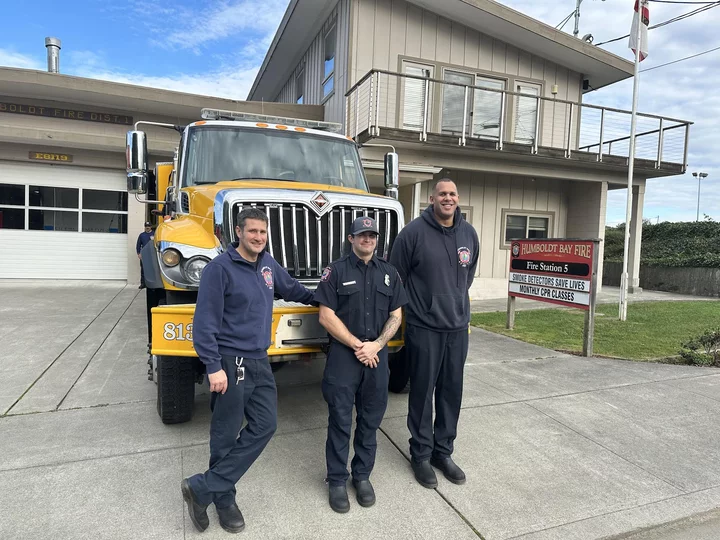LA Fires Underscore How Much California Has to Lose if Trump Withholds Disaster Aid
Ryan Sabalow and Alexei Koseff / Thursday, Jan. 9 @ 7:40 a.m. / Sacramento
Photo: CalFire, via Flickr.
As wildfires erupted in Southern California, so did a years-long feud between incoming president Donald Trump and Gov. Gavin Newsom.On the campaign trail, Trump repeatedly threatened to cut off disaster funding for California.
He stopped short of that on Wednesday, but in a social media post, he called Newsom “Newscum” and blamed his water policies for the three fires that have destroyed hundreds of homes, killed at least five people and displaced tens of thousands of Californians.
Trump said that due to Newsom’s environmental regulations, not enough water has reached Southern California and that fire hydrants went dry as a result.
“Now the ultimate price is being paid,” he said. “I will demand that this incompetent governor allow beautiful, clean fresh water to FLOW INTO CALIFORNIA. He is to blame for this.”
The Newsom administration called Trump’s post “pure fiction.”
Wildfire and climate experts say natural conditions — including eight months of drought — are to blame.
“The issue here is that it hasn’t rained yet,” said Alexander Gershunov, a research meteorologist at UC San Diego’s Scripps Institution of Oceanography.
Plus, these fires have been pushed by Santa Ana wind gusts as high as 75 mph. In those conditions, burning embers can blow miles from their ignition source and entire neighborhoods can erupt in minutes.
“You’ll never have enough water to put out a Santa Ana fire,” said Zeke Lunder, a California wildfire expert who’s been tracking and mapping the fires’ progress.
The bigger question looming over California is whether Trump’s feud with Newsom will cause him to act on his promise to cut federal disaster aid to the state when he takes office on Jan. 20.
On the campaign trail last year, Trump vowed that “we won’t give (Newsom) money to put out all his fires” unless the Democratic governor agreed to divert more water to California farmers. Two former Trump administration officials later told Politico that Trump initially withheld approval for disaster aid for California’s deadly 2018 wildfires, until aides showed him that many of the residents of the affected areas had voted for him.
A president can slow down the process of approving aid, or not declare a disaster, a decision critical to a state receiving federal relief funding. A 2021 federal report found that the Trump administration delayed $20 billion in disaster aid to Puerto Rico after Hurricane Maria in 2017.
Federal funding typically pays for around 75% of the costs of rebuilding public infrastructure such as roads, sewers, water systems, parks and fire stations, officials say. That means California would have to come up with billions of dollars in additional money after major disasters if Trump follows through on his campaign rhetoric.
Federal disaster funds also help those who’ve lost their homes find temporary living quarters. Federal programs can help with home-rebuilding costs not covered by private insurance.
Newsom preparing for uncertain disaster funding
Newsom has taken Trump’s threats seriously enough that, in the fall, his administration began developing plans to establish a backup emergency response fund that the state could draw from if Trump refused to make federal aid available. It’s unclear if Newsom will follow through with the idea in his formal budget proposal, which is expected Friday.
“What you see with the president-elect is, you know, fire and fury often signifying something. You see fire and fury often signifying nothing,” Newsom said at a press conference Monday, where he cautioned that California’s fiscal stability is uncertain under the incoming Trump administration. “And you have to sort of work through all of that.”
On Wednesday, the outgoing Biden administration pledged federal help and is already sending disaster aid to the state, thanks to the $100 billion Congress approved in December.
President Joe Biden, who was already in California to designate a new national monument and for the birth of his great-grandson, made a brief public appearance at a Santa Monica fire station on Wednesday morning to pledge his support for the response.
“We’re prepared to do anything and everything, as long as it takes, to tame these fires and help reconstruct and make sure we get back to normal,” Biden said. “It’s going to be a hell of a long way. It’s going to take time.”Newsom, who joined Biden, said the president’s quick declaration of a major disaster “means the world to us.”
“It’s impossible for me to express the level of appreciation and cooperation we received from the White House and this administration,” Newsom said. “So on behalf of all of us, Mr. President, thank you for being here. And not just being here today. Thank you for being here since the minute of this incident.”
Most of California’s congressional delegation — including U.S. Sens. Alex Padilla and Adam Schiff and 47 House members, both Democrats and Republicans — signed onto a letter urging Biden to approve the declaration Wednesday.
“The severity of these wildfires requires additional coordination and a wider range of long-term federal recovery programs,” the lawmakers wrote.
When asked Wednesday about Trump’s past threats to withhold disaster aid to California, Padilla warned that “our response to these disasters cannot become a partisan issue, and I will continue fighting to secure the necessary resources for our state’s recovery.”
How federal money rebuilt Paradise, Santa Rosa
In communities such as Paradise and Santa Rosa that suffered through similar catastrophic fires within the past decade, officials there said their communities wouldn’t have been able to rebuild without federal help.
“If we hadn’t had those types of funds to do the basic infrastructure that we’ve already done and are currently doing, I don’t think we would have recovered at all. It is such a significant piece of recovery,” said Collette Curtis, the recovery and economic development director for the town of Paradise. An early morning fire on Nov. 8, 2018 pushed by powerful winds destroyed most of the town in a matter of hours. Eighty-five people died; 18,000 buildings were destroyed.
Curstis estimates that Paradise has received at least $375 million in federal aid since the fire.
A year before the Paradise fire, thousands of homes in the city of Santa Rosa and surrounding communities burned in the Tubbs Fire – another wind-driven inferno that killed 22 people.
The federal government provided at least $366 million in direct aid to communities affected by the Tubbs Fire and other fires that year, according to estimates from the office of U.S. Rep. Mike Thompson, a Democrat who represents the region. Santa Rosa alone received $218 million, said Assistant City Manager Jason Nutt.
Without that much federal help, Santa Rosa wouldn’t have recovered, said the city’s former mayor, Chris Rogers, who was just sworn in as the region’s Democratic Assemblymember.
“Without the help of the federal government, not only would we potentially not have been able to rebuild, but we certainly wouldn’t have been able to rebuild as quickly,” Rogers said.
Rogers called Trump’s threat to cut disaster funding for California communities “inhuman.”
“This is a time when people need the most support, when they’ve lost everything,” Rogers said. “That’s the time when they need government to function for them. And so, to me, it’s completely unconscionable that you would choose that as not just to make a statement, but as a leverage point to try to get other things that you want. It’s wildly inappropriate.”
###
CalMatters reporters Stella Yu and Alastair Bland contributed to this story.
CalMatters.org is a nonprofit, nonpartisan media venture explaining California policies and politics.
BOOKED
Today: 3 felonies, 9 misdemeanors, 0 infractions
JUDGED
Humboldt County Superior Court Calendar: Friday, Dec. 26
CHP REPORTS
8750 Briceland Thorn Rd (HM office): Car Fire
0 Sr299 (RD office): Trfc Collision-No Inj
ELSEWHERE
RHBB: Expect Up to 30-Minute Delays on Highway 36 Monday During Slide Removal Near Grizzly Creek
OPB: Some cannabis works about as well as ibuprofen against chronic pain, OHSU-led review finds
KTLA: 19 rescued in Southern California human trafficking sting
KRON: Body found in Monterey Bay, sheriff’s office investigating link to suspected shark attack
OBITUARY: Cindy Miller, 1960-2025
LoCO Staff / Thursday, Jan. 9 @ 6:56 a.m. / Obits
Cindy Miller, born Cynthia Jean Oldham, on May 22, 1960, passed away on Friday, January 3, in St. Joseph Hospital, the same hospital where she was born.
Cindy is survived by her significant other, Tom Browning; son, Brandon Canonica; granddaughter, Crystal Canonica; great-granddaughter Audrey Rogers; her dad, Ray Oldham, sisters and their families Victoria Shatwell (Ken) and Debbie Oldham-Auker (Jim), numerous nieces and nephews and lastly, but certainly not least, her fur babies, Ozzy, Yoda and Oreo. She is preceded in death by her mom, Marilyn Oldham, and husbands, Fred Canonica and Don Miller.
Growing up in Eureka, Cindy attended Alice Birney Elementary School, where she played the clarinet and participated in Girl Scouts, Jacobs Jr. High School and Eureka Senior High School. She was a member of the graduating Class of 1978 and enjoyed attending their class reunions. She spent her younger years camping every summer with her family in Southern Humboldt County at French’s Campground, sunbathing on the Eel River, riding a mini bike, square dancing and roasting marshmallows over an open fire. Cindy has remained friends with those whose families also camped at French’s.
Shortly after high school Cindy married and moved to Bamburg, Germany, where her husband was stationed in the Army. Bamburg is where her son, Brandon, was born. While there, they once took a trip, with other Army families to Paris, France. This was in the middle of summer on a bus without air-conditioning … an adventure to say the least. They also got to experienced a traditional German wedding and reception “Prost!” As was Cindy’s style, she remained friends with several of those she met while in Germany.
Cindy was a huge NASCAR fan, Kevin Harvick to be specific. She rarely missed a race on TV. During the season, her weekends were planned around the races. She also enjoyed attending the races at Redwood Acres. Cindy attended different car shows in Northern California/Southern Oregon as a member of the Turd Heads, with her parents. Cindy was helpful with the logistics of putting on Cruz’n Eureka Car Show and the auctions they held that benefited Boys and Girls Club of the Redwoods.
Arts and crafts were her passion She enjoyed it all and was very creative and skilled at her “craft.” She most recently was enjoying painting rocks, hiding them and finding others’ painted rocks others around Humboldt County. She was a member of several rock-painting groups.
Rather than flowers, if you’d like to make a donation on Cindy’s behalf, Hospice of Humboldt, Wounded Warriors, St Jude’s or the Sequoia Humane Society are organizations that had a special meaning to her.
We will have a celebration of life to remember and honor Cindy in May, around her birthday.
###
The obituary above was submitted on behalf of Cindy Miller’s loved ones. The Lost Coast Outpost runs obituaries of Humboldt County residents at no charge. See guidelines here. Email news@lostcoastoutpost.com.
OBITUARY: Joseph Ryan Peters, 1977-2024
LoCO Staff / Thursday, Jan. 9 @ 6:56 a.m. / Obits
On October 9, 2024, Humboldt County lost an extraordinary friend, IT
guy, shark-and-snark-loving, snuggable bear of a man. Joseph Ryan
Peters, known as Ryan, was born May 10, 1977 in Mountain View to
Martha S. Peters and John R. Peters, and grew up in the Bay Area. He
graduated from Cupertino High School, Cupertino, in 1995.
An ex-girlfriend and life circumstances brought Ryan first to Garberville, where he honed his IT skills and earned four Associates of the Arts degrees from College of the Redwoods:
- College of the Redwoods, Eureka. Received an Associate in Arts in Transfer Studies, 12/15/2000
- College of the Redwoods, Eureka. Received an Associate in Arts in Natural Science/Mathematics 12/15/2000
- College of the Redwoods, Eureka. Received an Associate in Arts in Humanities 12/15/2000
- College of the Redwoods, Eureka. Received an Associate in Arts in Social Science 12/15/2000
He eventually made his way north to Eureka, where he made his mark on the community around him.
He worked as the entire IT department of RCAA since 2009, shouldering the responsibility of keeping this non-profit’s tech and internet access running smoothly with his remarkable skills in computer sciences. He was a dependable and tireless volunteer for the local community, pouring countless hours into Kinetics, the IMPropriety Society and fetish nights. Ryan took on jobs others didn’t want to do and managed them with his stubborn, and some(often)times snarky persistence.
While these above details matter, none of them matter as much as the kind of friend that Ryan was. He was the friend who could be counted on to show up in a moment of crisis. He was the ultimate problem-solver and shared this skill with those he loved. He was immensely huggable, and had a contagious giggle (Whiskey Shits! IYKYK). He was one of the best shit-talkers known to man, and loved nothing more than a good gossip session. His loyalty was unreserved — if he loved you, it was for life.
Of course, no one is perfect, and Ryan was no exception. He could offer the sassiest advice and commentary on your life; it sometimes stung but you always knew he was right. His beautiful tenacity could turn into stubborn resistance — he dug his heels in like nobody’s business! He was filled with contradictions: a gun-loving, motorcycle-riding, nerdy leftist.
With his death we strive to remember those aspects of him that brought the most joy and will be the most missed: an insatiable curiosity about the sciences, art, music, and people; a deep love for animals, particularly birds and sharks; immense knowledge and wisdom; a sassy, quick-wit; loyalty and trustworthiness; insane creativity; the best giggle in town; and a hug that could comfort the most anxious among us.
Joseph Ryan Peters is survived by his mother, Martha S. Peters, San Jose, father, John R. Peters, Gresham, Oregon, brothers, John and James of San Jose, the late Mr. & Mrs. H. F. Strickland of Gainesville, Florida and the late Mr. & Mrs. John Peters of Snellville, Georgia.
His large circle of friends who became family include: Kati, Nawdy, Q and Yvonne, Diamond and Griff, Laura and Ryan, Maxwell and Teresa, SuperK8 and Silas, Gin, Cas, Julia, Tina, Natalie and too many more to list. Please join this motley crew in a remembrance of Ry’s life on Sunday, January 19, 11 a.m. at Synapsis, 1675 Union St, Eureka.
###
The obituary above was submitted on behalf of Ryan Peters’ loved ones. The Lost Coast Outpost runs obituaries of Humboldt County residents at no charge. See guidelines here. Email news@lostcoastoutpost.com.
Design Review Committee Narrowly Approves New Plans for Eureka’s EaRTH Center
Isabella Vanderheiden / Wednesday, Jan. 8 @ 4:43 p.m. / Housing , Local Government
The Eureka Design Review Committee. From left to right: Gailey Browning, Kassidy Banducci, Chuck Ellsworth and Ryan Cameron. | Image: Screenshot
###
At a public hearing this morning, Eureka’s Design Review Committee narrowly approved new design plans for the long-awaited EaRTH Center, a four-story housing and transit development slated for two city-owned parking lots on Third Street between G and H streets, behind Lost Coast Brewery.
The EaRTH Center — shorthand for the Eureka Regional Transit & Housing Center — will host the Humboldt Transit Authority’s regional transportation hub on its ground floor, plus five commercial spaces for businesses. The upper floors will feature 46 residential units designated for low- and very-low-income households, including three studios, 18 one-bedroom, 13 two-bedroom and 12 three-bedroom apartments. Residents will have access to communal amenities on the second floor, including a community room with a kitchen, a fitness room, and a large outdoor terrace with a playground.
The northeast corner (Third and G streets) of the EaRTH Center depicted in the Servitas proposal (left) and Danco (right). | Images via City of Eureka
The project has changed quite a bit since it was approved in February 2022 by the Eureka City Council, as seen in the renderings above. When plans for the EaRTH Center were drawn up a few years ago, the development was billed as a 30-unit housing project for students and traveling medical staff. At that time, the city was working with Cal Poly Humboldt and Servitas, a student housing management company, to create much-needed housing for incoming students. However, the university and Servitas later left the project due to expenses.
The city briefly considered a partnership with College of the Redwoods, but the slow approval process for obtaining the necessary grant funding led the city to look elsewhere. Eager to get the project back on track, city staff asked if Danco would be interested in taking over the project, and in June 2024, the city council unanimously approved a resolution that authorized the City Manager to enter negotiations with Danco Communities for a Disposition and Development Agreement (DDA).
The redesign includes significant changes to the building’s façade and exterior, with a concrete base and green metal siding on the upper floors. Senior Planner Lisa Savage said the modified plans include new bus shelters along H Street, expanded sidewalks and electric vehicle charging stations.
“There also be a major [re]configuration of H Street between Third and Fourth streets,” Savage told the committee. “The west lane – where the bus shelter currently is located – will become a bus-only lane, and a new bike lane will run on the eastern side of the street. The current street parking configuration on the east side of H Street between Third and the alley [behind Lost Coast Brewery] will change from angled to parallel, which will cause the street to be reduced to one lane [for regular traffic] in this section.”
The reconfiguration will further reduce parking near the EaRTH Center, an issue many downtown and Old Town business owners have expressed concern about since it was first proposed.
Committee Vice-Chair Gailey Browning asked how many additional parking spots would be removed from Third Street under the current plan. Savage said the reconfiguration would eliminate parking on the south and east sides of the project, but she could not provide an exact number.
Committee member Chuck Ellsworth asked why Danco had decided to change the design, noting that the original rendering was “much more compatible with the community.”
Caitlin Castellano, the city’s deputy director of development services, noted that the previous rendering had been created by the former developer, Servitas, and that Danco decided to adopt a different, more cost-effective design. “There was no requirement by the city council or the Humboldt Transit Authority to retain the original design,” she added.
Browning felt the modified design was “inharmonious” with the rest of Old Town. “I think this is such an important project that there’s room for improvement on it,” she said. “I think the roof pitches could be more dramatic, I think they could add more window trim, I think the horizontal [and vertical] banding could be more pronounced. … I think the deck is a lovely edition, but I’d love to see some iron railing to pronounce that there’s a deck because you really can’t tell that it is from afar.”
Ellsworth seemed to agree, referring to the current rendering as a “cookie-cutter design.” He emphasized his support for the EaRTH Center but said, “It’s [in the] wrong place and it’s the wrong design for the community in that area.”
Committee member Ryan Cameron said he liked the building “overall” but asked if the developer would be willing to incorporate brick into the design to match some of the buildings nearby.
Garrett McSorley, the project’s current architect, pushed back on the committee’s assertion that his design is a “cookie-cutter” project. “From my perspective, this is a very high-quality project,” he said.
“We can incorporate different materials,” McSorely continued. “You know, brick is definitely one of the things that we talked about early on in the process but we found that brick is a budget-buster. It’s very, very expensive and it doesn’t provide the [degree] of long-term maintenance that the materials we have shown are. … Repeating and using the same materials that are already there in Old Town doesn’t necessarily respect Old Town. … We’re just a block down from the Carson Block Building – a gem of a building – and trying to repeat and copy that building would be a mistake, in my opinion.”
McSorely acknowledged that the metal siding may look “flat” in the digital renderings, but said it will look “more interesting” in real life. He also expressed interest in incorporating a pattern or design into the concrete base on the ground floor of the building.
Browning asked McSorley if he would be willing to increase the pitch of the roof to provide a more dynamic design. Again, he acknowledged that the digital rendering “looks boring” but advised against upping the pitch because it would increase shading. Increasing the pitch could also interfere with the solar panels that will be installed on the roof of the building, he said.
“These projects are net zero energy,” he continued. “The families who [will] live [t]here [will] have utility bills of, like, $10 a month and the way that’s done is through the roof design. If we wanted to create a full new roof with, you know, spires and different gables, those all drastically reduced the amount of solar panels we could fit in the project and it has a dramatic impact on the residents in the future.”
During the public comment period, nearly all of the speakers spoke in favor of the project, underscoring the need for more affordable housing in Eureka. One speaker called the modified project design a “bait and switch,” comparing the new rendering to the veteran’s resource center on Fourth Street, across the street from the North Coast Co-op. “That’s probably one of the least attractive buildings in Eureka, in my opinion,” he said.
After a bit of discussion among committee members, Chair Kassidy Banducci made a motion to approve the modified design, which was seconded by Cameron. The motion failed in a 2-2 vote, with Browning and Ellsworth dissenting.
Development Services Director Cristin Kenyon advised the committee to come up with a new motion, otherwise, its decision to deny the project design would almost certainly be appealed to the Eureka Planning Commission.
The committee rehashed some of the design elements with the architect and came up with a short list of modifications to the project, including wood paneling at the building’s main entrance and thicker horizontal banding between floors on the façade.
Before the committee could take a second vote, Browning left for an appointment. After a bit of additional discussion, Banducci came up with a motion that passed 2-1, with Ellsworth dissenting.
###
Humboldt Bay Fire Engine Dispatched to Help Battle SoCal Wildfires
LoCO Staff / Wednesday, Jan. 8 @ 2:05 p.m. / Fire
Humboldt Bay Fire release:
This morning Humboldt Bay Fire was requested to assist with an available engine to respond to the Palisades Fire in Los Angeles County. Our Type 3 Engine as well as an Engine from Fortuna Fire are leaving Humboldt County to meet with a group of three Sonoma County fire engines in Petaluma. From there all five engines and a strike team leader will be driving through the night to LA.
Once at the Palisades Fire, our crew and the rest of the strike team will likely go directly to work. Humboldt Bay Fire is happy to provide apparatus and personnel to any agency in need, and we know that would be reciprocated. Working under unified command, all crews will be hard at work to prevent any further devastation to the Los Angeles County affected area. HBF hopes all personnel involved remain safe and return home.
(PREVIEW) The Makers of the New Baduwa’t Documentary Want People to Get Mad About the River
Dezmond Remington / Wednesday, Jan. 8 @ 10:56 a.m. / Activism , Film
The Mad River/Baduwa’t at sunset. By Dave Feral.
It’s December 1849, and explorer and naturalist Josiah Gregg is alone. He is furious. He is hungry. His buddies absconded to get a meal at a nearby Wiyot village, leaving him stranded at a river they were resting at while he drew up a map of the area they explored. He crossed the river and found his crew.
“His cup of wrath was now filled to the brim,” a later recount of the expedition would put it, “but he remained silent until the opposite shore was gained, when he opened upon us a perfect batter of the most withering and violent abuse.”
After a minute everyone relaxed, but the incident remained fresh in Gregg’s mind. He christened the river he crossed in pursuit of bread and revenge the “Mad River” on his map. The U.S. government bought the map, and over the following decade, settlers colonized the area Gregg charted. 175 years after Josiah Gregg had a fit on the banks of a river nameless to him and his party, people still call it the Mad.
But there were people living near that river thousands of years before Gregg’s tantrum, and they called it a different name: Baduwa’t, “free-flowing river.” Almost two centuries after the river was given the Mad moniker, people are trying to change it back.
Dave Feral talks slowly, but he makes up for it by way of persistence. Every answer to every question ricochets around the point for a while before hitting a glancing blow.
Feral is the founder and executive director of the Baduwa’t Watershed Council (BWC), an organization dedicated to preserving the health of the river. He’s also a driving force behind the recently released Baduwa’t, a documentary about the river’s health, its turbulent history with outsiders and the Wiyot effort to both formally and colloquially change the name.
“I’m way too verbose, so you gotta cut me down,” Feral said in an interview with the Outpost. “There’s piles of my stuff on the floor.”
Mostly composed of gorgeous river b-roll and interviews with everyone from Wiyot tribal members and scientists to county supervisor Steve Madrone to Feral himself, the work on the film started in 2021 and wrapped last year. It had a private premiere at the Arcata Theatre Lounge last month. Feral and the film’s co-director, Michelle Hernandez, a member of the Wiyot Tribe, hope to secure a public release in February at the Eureka Theater.
It’s a trim film that touches on a lot in its 41-minute runtime. Feral and Hernandez both summed it up as a story about the river as a whole and the people that use it.
“It’s about hope and changing a name,” Hernandez said. “It’s also about how we got to where we are currently with the river’s health. Basically, ‘What can a community do before it’s too late, before it gets sick?’”
The BWC hopes they can convince their audience of the importance of changing the name of the river back to Baduwa’t. Hernandez and Feral argue that beginning a public discussion about changing the name will draw more eyes to the ecological health of the river.
“I thought for many years about the Baduwa’t before this transpired into the story it is now,” Feral said. “At a certain point, I went ‘You know what? If we begin to share the story of Baduwa’t, more people will become aware of the river…’ I think that’s the impetus, to say ‘What would it be like if we just started the process of getting people to recognize the name Baduwa’t instead of Mad?’”
This renaming effort is part of a larger narrative, in Humboldt and around the U.S. and worldwide, of indigenous-led efforts to rename places in the original native tongue. In Humboldt, Patrick’s Point State Park became Sue-Meg in 2021. There’s even a program the Wiyot tribe runs to find Soulatluk place names for agencies that want one.
Feral says there has been a backlash about the proposed shift to Baduwa’t, a kind of entrenched nostalgia from people whose ancestors lived in Humboldt for a while and always called it the Mad and see no reason to change it back.
“There have been a couple people on projects I’ve worked on … they’re complaining on public forums on Facebook,” Feral said. “I’m like, ‘Hey, you know what? To be accurate, this name existed way before anyone you’re related to got here and pushed some other people off of their land.’”
Feral knows firsthand that the process of changing names isn’t simple. Several years ago, he changed the name of the BWC from its previous name, the Mad River Alliance. Board members questioned the move. State grant checks made out to Mad River Alliance had to be fixed. People still complain about the adjustment.
Hernandez and Feral also believe that the original renaming of the river was symbolic of greater injustices, both to the Wiyot people and the ecosystem as a whole. Reclaiming Baduwa’t would be beneficial for both the community at large and the river itself.
“The renaming of Baduwa’t to ‘Mad River’ marked the beginning of a series of destructive events, including the gold, timber, and green rushes, that have severely impacted the watershed,” the BWC website reads.
“The Wiyot never changed the name,” Feral said. “They never gave up sovereignty of their land, their tribe, or any of the names they used before colonization occurred. I think that opening up the dialog and helping us understand how we see things from a colonial perspective versus [how] the Wiyot tribes or indigenous people see things is very important, because it begins the healing process that’s not just looking at the landscape and the damage that was occurred when the gold rush, the timber rush, and the fish rush occurred, and all the other atrocities that occurred with the capitalist colonization 175 years ago, but also recognizing how things had been managed before.”
Feral thinks Baduwa’t is an essentially hopeful film, and he claims many people that have seen it agree with him — but it can be hard to be optimistic during this film, when much of it focuses on how poorly the river is doing. The steelhead salmon population of the river is the smallest it’s ever been. Illegal water diversions for illicit cannabis grows are making it hotter. Clearcuts and logging roads dump tons of debris into the river. But Feral and Hernandez believe that a re-branding of the river back to Baduwa’t could help ameliorate those conditions by drawing more public attention to its problems.
“I’m hoping when I go home [to Humboldt] I hear more people referring to it as Baduwa’t and not the Mad River,” Hernandez said. “I hope [the film] helps cause a movement not just here, but throughout the United States. We’re seeing what happened, and we’re hoping that other people decide to reclaim other names that have been changed throughout the U.S. I hope this causes a movement so that we have more say in how we take care of this land, so we can prevent climate change from causing more damage than it’s already causing.”
Too Wet and Too Dry: The Crazy North-South Gap in California’s Rain
Alastair Bland / Wednesday, Jan. 8 @ 8:02 a.m. / Sacramento
A remarkably wet kickoff to Northern California’s rainy season has coincided with a desperately dry fall in Southern California — a huge disparity, perhaps unprecedented, between the haves and have-nots of rainfall.
Los Angeles usually gets several inches of rain by now, halfway into the rainy season, but it’s only recorded a fifth of an inch downtown since July, its second driest period in almost 150 years of record-keeping. The rest of Southern California is just as bone-dry.
At the same time, much of the northern third of the state has weathered nearly two months of storms, flooding and even tornadoes. Santa Rosa, north of San Francisco, has received more rain than nearly any other city in California — nearly two times its average rainfall to date. At the city’s airport, almost 7 inches fell on Nov. 20 alone, an all-time daily record.
Northern California is always wetter than the semi-arid southern half. But the scale of the north-south gap that has persisted for several months has stunned experts.
“There have been few if any years since 1895 … that have been so much above-normal in the northern part of the state while simultaneously so dry in the south,” Daniel Swain, a UCLA climate scientist, wrote in his blog Weather West. He added, in an email exchange with CalMatters, that “it is likely that the current north-south disparity is record-breaking in magnitude by at least some metrics.”
This season’s stark imbalance isn’t bad in terms of water supply. That’s because Northern California’s rain and snow feed major reservoirs, which provide much of the water used by Californians. If this occurred in reverse — a wet south and a dry north — most of the water would remain uncaptured, providing little benefit for supplies.
Snowfall to date has followed a similar pattern, with relatively heavy snowpack accumulating in the northern Sierra Nevada and substantially below-average levels in the southern Sierra.

All of Southern California, between Kern County and the borders with Arizona and Mexico, is experiencing moderate to extreme drought so far this season. The dryness, along with fierce Santa Ana winds, ignited two major fast-moving wildfires in Los Angeles County on Tuesday.
But while the latest forecasts predict dry weather for at least the next 12 days, water suppliers aren’t panicking. They say thanks to ample precipitation two years in a row, their reservoirs and groundwater basins are brimming with water to supply Southern Californians.
“In terms of water reliability and water supply at this moment in Southern California, things are looking pretty solid,” said Mike McNutt of the Las Virgenes Municipal Water District, which serves 75,000 people in northwest Los Angeles County.
In addition, demand in the district has declined since the 2020 drought year by 23%, McNutt said.
Statewide, average per capita water use has declined sharply since the 1990s, in spite of a growing population. Last July, state officials approved controversial and costly mandatory conservation rules that force 405 cities and other urban suppliers serving about 95% of Californians to meet individualized water budgets that decline over time.
Orange County Water District Chief Hydrogeologist Roy Herndon said his agency, which supplies groundwater to the north half of the county, has enough supply to carry its 2.5 million customers through the worst of any potential droughts — multiple years in a row with minimal rainfall. “Three years, no problem. I’d say even five years,” Herndon said.
The Metropolitan Water District of Southern California — which serves 19 million people mostly with imported water — also has an abundance, “with a record 3.8 million acre-feet of water in storage,” according to Interim General Manager Deven Upadhyay, who issued a statement last week. That’s enough water to supply 40 million people for a year.
Last year was the eighth wettest year statewide in a century, and 2024 was about average. Now, the state’s largest reservoirs are well above their average levels for this time of year. Lake Oroville, the State Water Project’s largest, contained 128% of its average to-date storage as of Jan. 6. Lake Shasta was at 130%. Casitas and Diamond Valley reservoirs, key holding facilities for Southern California’s supply, are both almost full.
Moreover, snowpack conditions in the Sierra Nevada are promising.
As of Monday, the Sierra Nevada contained a snow water equivalent of 103% of average. The northern end of the mountain range is at 150% — a reassuring status since it’s the source of the bulk of the reservoirs. The southern end, however, now holds just two-thirds of its average for early January.

At right, California Department of Water Resources staff member Andy Reising conducts the first snow survey of the 2025 season at Phillips Station in the Sierra Nevada., on Jan. 2, 2025. Photo by Nick Shockey, California Department of Water Resources
“Off to a better start this water year than we were last year, but much remains to be seen in terms of how this water year actually ends up,” said David Rizzardo, hydrology section manager of the California Department of Water Resources.
The agency announced in early December that its State Water Project — which serves 750,000 acres of farmland and 27 million people — would be delivering 5% of requested water supplies to local agencies. Later in the month, after November’s atmospheric rivers pummeled Northern California, the department boosted the initial allocation to 15%. The allocation will likely jump again before the rainy season peters out — usually in April or May.
What’s in store for the next three months?
In California climatology, only one prediction is downright easy to make: Summers will be dry across most of the state. But California’s winters are extremely variable, and how the next three months — historically the wettest of most years — will unwind is anyone’s guess.
Michael Anderson, a climatologist with the California Department of Water Resources, said a single large storm could change the outlook for Southern California’s water year. But he also observed that most years that have started out so exceptionally dry have stayed dry.
“That is certainly the California story — bouts of very wet to bouts of very dry, flipping within a single season, flipping year to year, hoping that it evens out in the end.”
— John Abatzoglou, UC Merced climatologist
Of the ten times on record when Southern California’s coastal region had received less than an inch of rain by New Year’s Day, only once did the water year’s precipitation tally come out above normal, he said. Three of those times, precipitation levels reached almost average.
John Abatzoglou, a climatologist at UC Merced, said an abrupt shift in precipitation patterns into a full-on drought statewide, though not necessarily probable, would not be surprising, either.
“That is certainly the California story — bouts of very wet to bouts of very dry, flipping within a single season, flipping year to year, hoping that it evens out in the end,” he said.
Though it’s essentially a tossup how the rest of the year shapes up, there is a caveat: the onset of La Niña. The counterpart to the more prestigious El Niño, La Niña often features dry conditions in Southern California and wetter conditions farther north.
Alexander Gershunov, a research meteorologist at UC San Diego’s Scripps Institution of Oceanography, said the precipitation patterns seen so far this year, while somewhat consistent with La Niña, are more the “outcome of natural variability.”
“La Niña signals typically don’t kick in until January,” he said.
A classic La Niña could draw out current patterns through the remainder of the winter, though Gershunov also leaned toward the possibility that the year would finish up a wet one. Citing 2011, 2017 and 2023, he said “three of the wettest years this century were La Niña years.”
Southern California’s dry conditions primed the region to burn. The largest wildfire, the Palisades Fire, in Los Angeles County’s Pacific Palisades, grew to more than 3,000 acres within hours, forcing evacuation of tens of thousands of residences and destroying homes. The Eaton Fire ignited in Altadena, near the San Gabriel Mountains, on Tuesday night.
Wetter wets and drier dries
Increasingly pronounced weather extremes have been a growing area of interest among scientists and state officials, who frequently cite “weather whiplash” — “wetter wets” and “drier dries” — as one of the most pressing climate-related challenges facing California.
Mid-winter wildfires are just one potential outcome of this climate pattern. Increasingly erratic and unpredictable water cycles are another. California’s intricate system of reservoirs, canals and pumping stations was built to accommodate winter rainfall followed by a steady flow of snowmelt in the summer.
“Our reservoir system was predicated on the notion that much of our water would stay frozen in the mountains for months,” said Jeffrey Mount, a senior fellow and water supply expert at the Public Policy Institute of California.
But the climate that has historically supported this pattern is changing.
“Hots are getting hotter, dries are getting drier, the wets are getting a lot wetter,” said Gov. Gavin Newsom in a recent press briefing. “You have simultaneous droughts and simultaneous rain bombs.”
“We’re facing a future without snowpack, and we’re not ready for that.”
— Jeffrey Mount, Public Policy Institute of California
One trend frequently described is that of warmer and shorter winters, compressed from both ends. This causes more precipitation to fall in a shorter period of time, more of it to fall as rain, and more of the snow that does fall to melt earlier in the season.
Climate models suggest that the state’s snowpack — a resource that on average has provided 15 million acre-feet of water annually, or nearly four times the capacity of the state’s largest reservoir — could mostly disappear by the end of the century, when winters may be too warm to support long-lasting snow on all but the highest peaks and ridges in the state.
“The outlooks for California are a warmer future, where we see that snow line … moving up the hill, towards the end of the century, really leaving that seasonal snowpack to the higher elevations,” Anderson, at the Department of Water Resources, said.
Mount said the decline of snowpack is happening slowly on average, but with extreme snow drought periods increasingly falling into the bar charts of California history. Notable gaps are seen from 2012 to 2015 and 2020 to 2023 — low-snow periods that could reflect future norms.
“We’re facing a future without snowpack, and we’re not ready for that,” Mount said.
This shifting hydrology has prompted calls from many water supply advocates for more reservoirs and enlargement of existing ones, to capture more water at once. The long-delayed proposed Sites Reservoir — one of Newsom’s frequent rallying points — is well into planning stages, and other reservoirs are being enlarged.
Mount said relying on such concrete infrastructure enhancements will eventually prove much too costly. The solution, he says, lies underground.
“Our best hope is to aggressively start using groundwater for our main storage for the future,” he said.
Underground solutions
That’s not so easy in agricultural areas. Farms use such great volumes of water that it’s impossible to recharge many groundwater basins faster than growers pump it out, especially in the San Joaquin Valley. Water agencies and state officials are seeking ways to channel floodwaters into gravelly basins where water can rapidly sink in but logistical and regulatory barriers continue to stifle progress.
Because urban areas use relatively little water compared to farmland, local stormwater capture has made more of a splash. The Los Angeles Department of Water and Power captured more than 108,000 acre-feet of local stormwater in 2023 — about 20% of its annual demands — and diverted it into groundwater basins. Last year, the agency captured 41,000 acre-feet of stormwater in February alone.
Delon Kwan, the department’s assistant director of water resources, said city plans are afoot to increase stormwater capture to 150,000 acre-feet per year by 2035, in part by using urban parks as infiltration grounds.
Water recycling systems are another way to help drought-proof California communities. In his 2022 water supply strategy, Newsom set a target of 800,000 acre-feet of recycled water by 2030 and 1.8 million acre-feet by 2040. Some cities already reuse wastewater for irrigation or treat it after storing it in aquifers. Now direct potable reuse — sometimes erroneously called toilet-to-tap — has been approved in California.
Mount said Southern California has made great steps toward improving local water supplies, but climate change could limit the region’s potential for self-sufficiency.
“As you see increasing aridity in Southern California, with a climate more and more like the Southwest, you’re going to see increasing reliance on water from other areas,” he said. “If you haven’t got water to recycle, it becomes a real problem. If you haven’t got stormwater to capture, it’s a problem.”
###
CalMatters.org is a nonprofit, nonpartisan media venture explaining California policies and politics.




